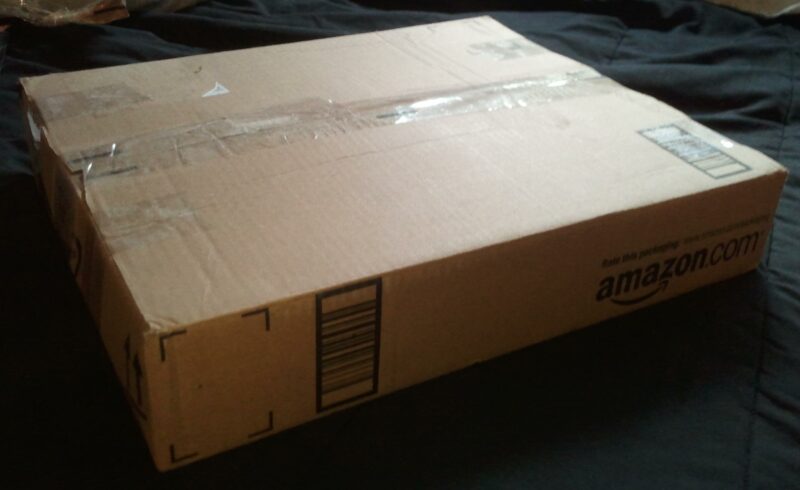Wonder Woman Poster # 5 FRAMED Wonder Woman #0 (1994) Brian Bolland
$74.99
Description
You are purchasing the item pictured, framed. Priority mail, tracking and $50 insurance is included with purchase. Item will be bagged to protect from dust, packed in packing peanuts and boxed. Just open box and hang it on the wall…makes a perfect gift!
Wonder Woman’s bulletproof bracelets were formed from the remnants of Athena’s legendary shield, the Aegis, to be awarded to her champion. The shield was made from the indestructible hide of the great she-goat, Amalthea, who suckled Zeus as an infant. These forearm guards have thus far proven indestructible and able to absorb the impact of incoming attacks, allowing Wonder Woman to deflect automatic weapon fire and energy blasts. Diana can slam the bracelets together to create a wave of concussive force capable of making strong beings like Superman’s ears bleed. Recently, she gained the ability to channel Zeus’s lightning through her bracelets as well. Zeus explained to her that this power had been contained within the bracelets since their creation, because they were once part of the Aegis, and that he had only recently unlocked it for her use. After the 2011 relaunch of the character, it was revealed that Diana was the daughter of Zeus and Hippolyta and that the bracelets are able to keep the powers she has inherited from Zeus in check. In addition, Hephaestus has modified the bracelets to allow Wonder Woman the sorcerous ability to manifest a sword of grayish metal from each bracelet. Each sword, marked with a red star, takes shape from a flash of lightning, and when Wonder Woman is done with them, the swords disappear, supposedly, back into her bracelets. As she has produced no other weapons from the bracelets, in this way. In October of 1994, all of the existing mainstream DC Comics titles released a special “0” issue to coincide with the Zero Hour crossover event. The purpose of the “0” issue was to reveal a previously unknown aspect of the title character’s background. After a long run in which artist George Perez accentuated the mythological aspects of Wonder Woman’s world, a new creative team took charge of the title in 1992, determined to make the Amazing Amazon sexier and more super-heroic. Supplying the covers for many of these issues was one of the leaders of the so-called “British Invasion” of comics, Brian Bolland, whose impeccable linework- combined with his increasing disenchantment with interior sequential art- have made him the go-to talent for pin-up quality covers since the 1990s. For visual inspiration, Bolland looked to supermodels. And he re-affirmed the centrality of Wonder Woman’s bullet-deflecting bracelets, an aspect of her costume said to have been inspired by jewelry worn by Olive Richard- the longtime companion of Wonder Woman creator William Moulton Marston. Wonder Woman is a superheroine created by American psychologist and writer William Moulton Marston and published by DC Comics. She first appeared in All Star Comics #8 in December 1941 & first cover-dated on Sensation Comics #1, January 1942. The Wonder Woman title has been published by DC Comics almost continuously except for a brief hiatus in 1986. Her depiction as a heroine fighting for justice, love, peace, and sexual equality has led to Wonder Woman being widely considered a feminist icon. Wonder Woman is a warrior princess of the Amazons (based on the Amazons of Greek mythology) and is known in her homeland as Princess Diana of Themyscira. When outside her homeland incognito, she is known as Diana Prince, a secret identity with credentials and identity bought from an Army nurse named Diana White who went to South America and married her fiance. She is gifted with a wide range of superhuman powers and superior combat and battle skills. She possesses an arsenal of weapons, including the Lasso of Truth, a pair of indestructible bracelets, a tiara which serves as a projectile, and, in some stories, an invisible airplane. Created during World War II, the character was initially depicted fighting the Axis military forces, as well as an assortment of supervillains. Since then, Wonder Woman has gained a formidable cast of enemies bent on eliminating the Amazon, including classic villains such as Cheetah, Ares and Circe and newer ones like Genocide and The Circle, as well as many gods and monsters from Greek mythology. Wonder Woman has also regularly appeared in comic books featuring the superhero teams Justice Society (from 1941) and Justice League (from 1960). In addition to the comics, the character has appeared in other media; most notably, the 1975–1979 Wonder Woman TV series starring Lynda Carter, as well as animated series such as the Super Friends and Justice League. Although a number of attempts have been made to adapt the character to live-action film, none have yet emerged. An animated film was released in 2009, with Keri Russell voicing the title role. Attempts to return Wonder Woman to television have faced problems, with a failed NBC Wonder Woman pilot in 2011 counting among more recent attempts. A pilot for The CW entitled Amazon was announced as being in development in September 2012, but by mid-2013 development had been paused due to the network’s dissatisfaction with the script. Wonder Woman has been featured in a variety of toys and merchandise. Wonder Woman was ranked 5th in IGN’s “Top 100 Comic Book Heroes Of All Time”. Brian Bolland (born 1951) is a British comics artist. Best known in the UK as one of the definitive Judge Dredd artists for British comics anthology 2000 AD, he spearheaded the ‘British Invasion’ of the American comics industry, and in 1982 produced the artwork on Camelot 3000 (with author Mike W. Barr), which was DC’s first 12-issue comicbook maxiseries created for the direct market. His rare forays into interior art also include Batman: The Killing Joke, with UK-based writer Alan Moore, and a self-penned Batman: Black and White story. Bolland remains in high demand a cover artist, producing the vast majority of his work for DC Comics. Bolland also contributed a large number of covers to Wonder Woman, beginning with William Messner Loebs’s first issue (#63, June 199271) after that author took over writer (and artist) George Pérez’s 1987 post-Crisis relaunch. Bolland recalls his time drawing Wonder Woman fondly, as one of the few occasions he actually sought work rather than being sought for work. He recalls “I usually sit at home optimistically hoping that people love me enough to ring me and offer me work. The end result is that most of the time I’m doing what other people want and not what I want. Wonder Woman was an exception. I happened to mention to Tom Peyer, my editor on Animal Man, that I’d love to draw Wonder Woman covers… at the time, despite her long history at DC, her iconic appearance, even her cult TV series, she wasn’t a character that A-list artists were lining up to draw. Well, I wasn’t an A-list artist, so I was keen to have a crack at her.” Bolland’s first cover saw Diana next to the headline: “The Stunning return of comics’ greatest heroine!” speaking directly to the reader the words “…Miss me?” Bolland’s covers over the next 30-plus issues laid the visual groundwork for the character subsequently reworked by writer-artist John Byrne, and saw Bolland illustrate up to and including the centennial issue #100. To prepare for his work, Bolland “clipped pictures of the most beautiful women of the time – Christie Turlington, Stephanie Seymour, etc.” saying that he was predominantly interested in their faces (“The body I generally made up”). Interested particularly in drawing the costume, which he feels “has to be one of the sexiest in comics,” he soon found the character removed from her normal costume in the storyline, “defeating, for me, the whole point.” For her return to her famous costume, Bolland produced one of his best known images: the Britannia-esque pose from Wonder Woman #72 (Mar, 1993). With typical modesty, he says that “images like that… usually arise when you’re completely stuck for an idea.” The image was so iconic that it was released as a poster and later turned into a statue. Shortly thereafter, Diana underwent another costume change – this time designed by Bolland, and mostly drawn on the interior pages by Mike Deodato. The black costume was roundly disliked, even by its designer, Bolland, who philosophically says only that “it was what was asked for at the time,” and – aside from Camelot 3000 – is “the only occasion” he was asked to design a costume. The new costume – black hotpants, halter top, straight hair (which Bolland did like) and “WW”-emblazoned jacket – was based, Bolland thinks, “on a Versace outfit I saw Cindy Crawford wearing in an issue of Vogue.”
>PAN>Frame is shrinkwrapped until time of purchase. Ships boxed with packing peanuts.
THE PERFECT GIFT!
Related products
-
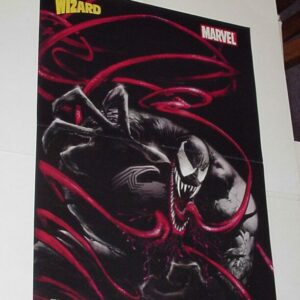
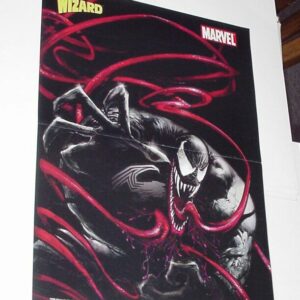
Venom Poster # 3 by Sam Kieth MTV Maxx Issue # 1 Cover
$39.99 Add to cart -


Captain America Poster # 9 In Chains by John Cassaday Issue 8
$29.99 Add to cart -

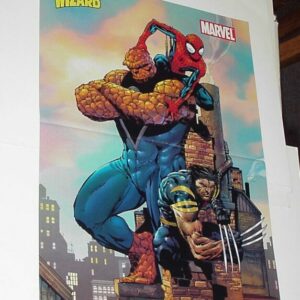
Ultimate Spider-Man Thing Wolverine Poster David Finch X-Men Fantastic Four
$29.99 Add to cart -
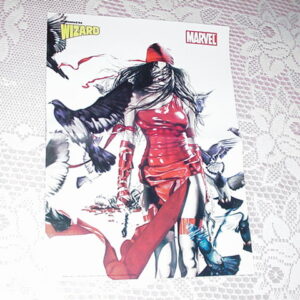
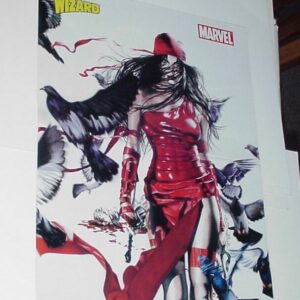
Elektra Poster # 2 by Rodolfo Migliari Daredevil Thunderbolts
$29.99 Add to cart




